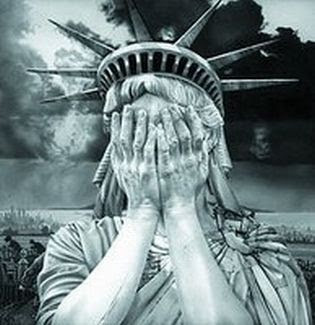
The two and a half weeks since Donald Trump`s inauguration seem longer. Does anybody else have the uneasy feeling that we are six or so months into the first term? If so then welcome to this blog. What follows is an interim depiction of Donald Trump as President through the lens of time and history. My first observation is that a lot has happened. The sheer multitude of Presidential orders, statements and comments on healthcare, abortion, trade agreements, US-Mexico relations, global warming, oil pipelines, immigration and other matters has sparked a media frenzy. Trump and his aides have declared war on the mainstream media and provoked some of the largest protests ever held in the United States. This in turn has generated further media coverage domestically and internationally. By January 27th the BBC website alone had published more than 200 stories and videos about, or relating to President Trump. The fact that much has happened dilates our sense of chronological time. Previous inaugural Presidencies did not begin with the same frantic intensity. Yet, one also feels immersed in an instantaneous present in which real-time events are disconnected from historical memory and the prospective future. These events, and their associated molecular reactions, reverberate throughout the mass media (print,radio,television) and social media (internet sites, facebook, mobile telephony, the twittersphere). Through multiple channels, multiple events and multiple reactions feed off each other continuously. Everybody, it seems, is part of the hyper-mediated spectacle – politicians, journalists, newscasters, commentators ,protestors, celebrities, media audiences, ordinary facebook users and texters.
This is the world of fake news, post truth politics and alternative facts. Amidst the 24/7 barrage of text, sound and imagery there is no time to verify, reflect or deliberate. Donald Trump works to accelerate the spectacle so as to disable critics and sow public confusion. Thus far, every executive order has been accompanied by a flurry of tweets for media and popular consumption. As the spread of protests and legal opposition challenges the executive order other high profile news events are generated out of the White House courtesy of Donald Trump`s twitter account. Yes,it is true that Federal judge James Robart has blocked the President`s 90 day immigration ban against seven designated Muslim-majority countries. But this is already yesterday`s news and, in any case, the President`s twitter post has denigrated Robart as a `so called judge` who has made a `ridiculous` order. In the world of alternative facts absolutely everything is a matter of opinion; let the twittersphere and social media decide. This disruptive style of governance has been deliberately designed by Trump`s ideological soul-mate, chief strategist and National security Agency appointee Stephen Bannon.
These developments unquestionably threaten liberal democratic principles,world peace and our common ecological future. But simply protesting against the Trump Presidency is not sufficient; that just magnifies the spectacle and reinforces Bannon`s strategy. Before taking to the streets (after the next outrage) some historical reflection is required. In my view President Donald Trump is a symptom of five malign tendencies in American society; rampant consumerism, declining media quality, diminishing civil liberties, social polarisation and working class disenfranchisement.
On the first point we need to re-read key writings from German-Jewish philosopher, sociologist and musicologist Theodore Adorno. Like many other European intellectuals he escaped fascist totalitarianism to settle in the United States. Adorno respected the constitutional traditions of his host country but felt uneasy about the spread of consumer culture. In a chapter entitled `The Culture Industry` from ` The Dialectic of Enlightenment` (1943) Adorno and his co-author Max Horkheimer criticised the increasing commodification of cultural expression. Music, film and news had become industrially mass produced and distributed in standardised formats for commercial profit. The growth of advertising, market research and the promotion of suburban consumer lifestyles normalised the continual acquisition of material goods-`I shop therefore I am`. Adorno later argued that commercial television cued audience passivity rather than social reflection upon society, history and prevailing power structures. In these circumstances public opinion was fashion-driven and potentially manipulable by demagogic leaders. Adorno`s analysis was in some respects undermined by the emergence of a new oppositional politics in the 1960s and 1970s. The feminist, civil rights and environmental movements generated mass mobilisations. Protests against the Vietnam war publicly exposed the brutalities of US military imperialism. Yet, in the decades following Adorno`s death in 1969 , oppositional politics dissipated and consumer culture became more entrenched. The establishment of the internet and social media gave advertisers unprecedented access to the private lifeworlds of citizens. Google pioneered the development of individuated commercial surveillance and Facebook allowed advertisers to monitor user generated content. A cyber-mediated culture of narcissism took hold; twitter postings, texting and selfies increasingly displaced literate communication. These tendencies together provided the preconditions for the spread of confirmatory bias (internet echo chambers), vindictiveness (trolling), and authoritarian leadership (with twitter followers). If Adorno`s analysis was overdrawn in the 1960s it is dead on the mark today.
Secondly, the decline in media quality as a precondition for Donald Trump`s political rise has been succinctly outlined in a recent commentary (Victor Pickard `Media Failures in the Age of Trump` polecom.org 2016 pp118-122). Pickard notes that Trump was very lucrative for commercial television. Cable news organisations reportedly made US $2.5 billion during the election season. Leslie Moonves, CEO of CBS candidly stated that Trump was producing considerable revenue for the network ,` The moneys rolling in and this is fun` (p119). When media organisations entirely depend on the sale of audiences to advertisers sensationalist news content prevails over journalistic inquiry. Meanwhile, journalists are less available to scrutinise politicians. Since 2006 the American newspaper industry has lost a third of its staff. Pickard remarks that bankruptcies increase `as readers and advertisers migrate to the web where digital ads generate a fraction of traditional ad revenue`. (p119). On the web millions of Americans rely on Facebook for daily news content. In this regard public concerns about fake news stories ignore the underlying issue. The proliferation of such news is `symptomatic of an unregulated news monopoly, one that is governed solely by profit imperatives` (p119 ).
I now turn to our third malign tendency. Now, I am aware that civil liberties have always been fragile in America. One need only ask Ameri-Indian and African –American activists, union leaders and any other coherent advocate of socialism. Nevertheless, a line was crossed during George Bush`s Presidency. Following the September 2001 9-11 attacks, on October 26th, the Patriot Act rescinded rights long protected by the Constitution and allowed for routine intrusions of the state into the lives of the citizenry. In 2002 Gore Vidal in an interview for the `LA Weekly` stated bleakly that the Federal government was `ready to lift haebus corpus, due process (and) the attorney-client privelege`. The Patriot Act thus enabled the institution of an `arbitrary police state`. President Obama`s failure to properly debate this legislation while in office makes it easier for Trump and Bannon to act despotically against Muslims, Mexicans and other marginalised groups.
Social polarisation ,the fourth malign tendency has a longer history. During the late 1970s, 1980s and 1990s America`s industrial heartlands were hollowed out. Manufacturing corporations moved to Mexico, China and anywhere else where wages were low and unions weak. Millions of US workers were abandoned just as Wall St investment banks became mega wealthy through financial speculation. Unemployed and precariously employed African- Americans were criminalised by racist police forces and incarcerated within a burgeoning prison-industrial complex. The white working class were left to bemoan the evaporation the American dream. For them, the post-war prospect of upward social mobility was effectively destroyed . There were plenty of villains to blame; Washington elites, condescending liberals, immigrants and, eventually, the Democratic Party . This constituency, nostalgic for the past, were always going to be drawn to a leader with a similar outlook. Trump is clearly nostalgic for the days when what was good for General Motor`s seemed good for America. There is some truth in this. Today`s high-tech corporates –Apple, Facebook, Google- employ far less people in proportion to their profits than the industrial corporates of the 1950`s.
Our fifth malign tendency; working class political disenfranchisement, was aided and abetted by the Democratic Party. During Bill Clinton`s Presidency the Glass –Steagall Act was repealed , derivatives speculation deregulated and the North American Free Trade agreement passed. The unemployed working class were forced into workfare regimes while the precariously employed and lower middle classes were cajoled by home- loan sharks into the sub-prime bubble. Under the Obama Presidency, after the financial crash, surviving mega-banks were bailed out at the expense of working class and middle class taxpayers. Bernie Sanders and his supporters sought to redress the situation during the 2016 Democratic primaries but were crushed by the Clinton machine. This systematic disenfranchisementof the poor by Democratic party elites was gleefully exploited by Donald Trump and his strategists.
Together these five malign tendencies in American society formed the preconditions for Donald Trump`s rise to the Presidency. Neither he or his advisors will reverse these tendencies but they are not entirely responsible for them either. Political opposition must look beyond Trump and establishment- liberal critics to publicly oppose the underlying US power structure- Wall St., transnational corporations, the military-industrial apparatus and their associated lobbying networks.
To this end, some intelligent foresight concerning the Trump Presidency will be necessary.
How will it`s future unfold? Read my next blog to find out..






Little to disagree with there, Wayne.
The part that is missing is that industrial society per se is the problem and cannot be fixed. Industrial society will both self-implode and will partially destroy or complete destroy the habitability of the Earth.
Politically and socially, no one knows what comes next, except that it will be bad. It has been bad since the 1970s. And we do know that the environmental predicament will be made ‘progressively’ worse. Indeed, it is now too late to do anything to prevent substantial planetary overheating, and time has almost run out for preparation for what is to come soon.
This video reviews how the scumbags at the top of the social and financial pyramid manipulated the masses, enriched themselves and ensured humanity remained on a path to ultimate catastrophe.
https://www.youtube.com/watch?v=sEE6ebgVtyQ&list=FLCJMQ6RwLJ8BHMIZ_0Fj_ag&index=8&t=444s
Once trump dismantles Medicare and Medicaid, the workers who supported that idiot will wake up to the mistake they’ve made. They should know by now, once a One Percenter, always a One Percenter.
Oh so true.
An excellent analysis Wayne. I look forward to your follow-up blog.
It seems to me that these problems can be traced back to the desire to maintain the kinds of profits that came with the acceleration of consumer capitalism after the war. People do not replace fridges, washing machines, etc. at the same rate as they acquire them when they are introduced. So the answer was to seek out a continual flow of new markets and cheaper workers, and to elevate a consumer class at home in order to secure consent and get away with destroying the no-longer-needed local working class. Any move Trump makes to restore local manufacturing risks bringing this card house down, but the anger of those who have been shortchanged is not going to go away. If capitalism doesn’t destroy itself first, populations will soon have to rein it in, as they reined in their armies in earlier centuries.
Outstanding assessment, Wayne. The working class will shortly be waking up to the fact that Trump is no saviour and he is there to represent the interests of the Oligarchy. That is, if he doesn’t provoke WW3 with China first. The man is a menace to world safety.
Hope? You, sir, are badly misnamed! 🙂
It is, however, a credible summary and I certainly want to see part 2.
Just make sure you publish it before Trump presses the big mushroom shaped red button…
Most people probably don’t relies but trump actually campaigned on all this……… democracy (in lower case) ?
Which begs the question Sam, is bigotry ok if the majority of those who vote, vote for it?
In which case, who is safe from the tyranny of the “majority” (of those who vote)? Imagine living in a world where your rights are at the whim of a capricious “majority”. I don’t think that’s the kind of world I want for me and my children.
At least he does what he says, Labour cannot even agree about their candidates, this lack of being decisive I find a bit frightening.
“At least he does what he says” So do other neo-liberals. So what’s your point?
Um..it is obvious
Great piece. Nice to find something well researched and readable about our American friends after a year and a half of online craziness. Look forward to part two.
Really good overview.Its a pleasure to read an analysis like this that doesn’t demonise one group or other, something sadly lacking in journalism today.
The whole shebang has become a juggernaut, and catastrophic collapse is probably inevitable, unless we can find a new way of “being” in the world
Twitter, Facebook, Google et al are slowly and gradually undermining democracy, as they serve as useful tools for the demagogues and manipulators of the click bait hungry masses.
Dumbing people down has never been made more easy, we are heading towards dangerous times, indeed.
Despite of all warnings, most carry on as usual, as if they are magnitised by their screens, same as most continue driving their cars each day, even though they contribute to the looming climate disaster that can one day end our human existence.
MADNESS RULES, it seems.
Wow, what an enlightened commentary Wayne’s post provides to us! This is stuff most will not even comprehend, I fear, as they are so conditioned into shallow, superficial or even dumb thinking, ruled only by consumerism and conformism to the trends they are constantly exposed to.
Comments are closed.